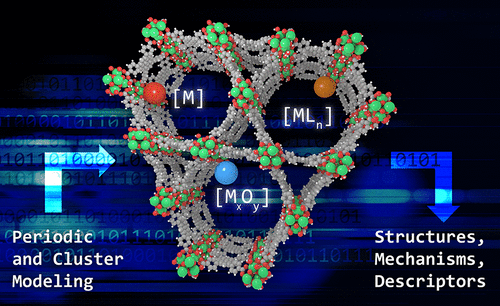当前位置:
X-MOL 学术
›
ACS Cent. Sci.
›
论文详情
Our official English website, www.x-mol.net, welcomes your
feedback! (Note: you will need to create a separate account there.)
Computational Design of Functionalized Metal–Organic Framework Nodes for Catalysis
ACS Central Science ( IF 12.7 ) Pub Date : 2017-12-21 00:00:00 , DOI: 10.1021/acscentsci.7b00500 Varinia Bernales 1 , Manuel A. Ortuño 1 , Donald G. Truhlar 1 , Christopher J. Cramer 1 , Laura Gagliardi 1
ACS Central Science ( IF 12.7 ) Pub Date : 2017-12-21 00:00:00 , DOI: 10.1021/acscentsci.7b00500 Varinia Bernales 1 , Manuel A. Ortuño 1 , Donald G. Truhlar 1 , Christopher J. Cramer 1 , Laura Gagliardi 1
Affiliation

|
Recent progress in the synthesis and characterization of metal–organic frameworks (MOFs) has opened the door to an increasing number of possible catalytic applications. The great versatility of MOFs creates a large chemical space, whose thorough experimental examination becomes practically impossible. Therefore, computational modeling is a key tool to support, rationalize, and guide experimental efforts. In this outlook we survey the main methodologies employed to model MOFs for catalysis, and we review selected recent studies on the functionalization of their nodes. We pay special attention to catalytic applications involving natural gas conversion.
中文翻译:

催化功能化金属有机骨架节点的计算设计
金属有机骨架(MOF)的合成和表征方面的最新进展为越来越多的可能的催化应用打开了大门。MOFs的多功能性产生了很大的化学空间,对其进行彻底的实验检查实际上几乎是不可能的。因此,计算建模是支持,合理化和指导实验工作的关键工具。在这种前景下,我们调查了用于建模MOF催化的主要方法,并且我们回顾了有关其节点功能化的近期研究。我们特别关注涉及天然气转化的催化应用。
更新日期:2017-12-21
中文翻译:

催化功能化金属有机骨架节点的计算设计
金属有机骨架(MOF)的合成和表征方面的最新进展为越来越多的可能的催化应用打开了大门。MOFs的多功能性产生了很大的化学空间,对其进行彻底的实验检查实际上几乎是不可能的。因此,计算建模是支持,合理化和指导实验工作的关键工具。在这种前景下,我们调查了用于建模MOF催化的主要方法,并且我们回顾了有关其节点功能化的近期研究。我们特别关注涉及天然气转化的催化应用。











































 京公网安备 11010802027423号
京公网安备 11010802027423号